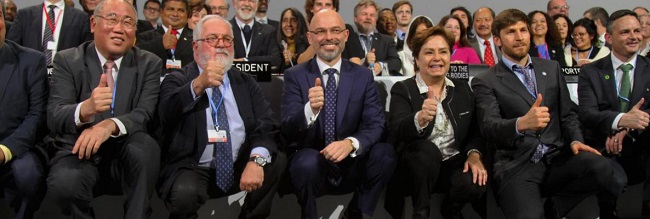When delegates adopted the 2015 Paris Agreement to widespread cheers and excitement, it was clear that further details needed to be negotiated on how the agreement would be implemented transparently and fairly for all.

Countries set a deadline for themselves to complete these negotiations on the implementation guidelines in 2018 at COP24.
Against the backdrop of rising global emissions and multiplying signs of climate change such as wild fires, droughts and storms, countries began negotiating in 2016.
“Recognising the urgency, governments overcame difficult political and complex technical issues to agree the Katowice Climate Package at COP24,” said the Executive Secretary of the United Nations Framework Convention on Climate Change (UNFCCC), Patricia Espinosa.
“The Katowice outcome is a breakthrough that all governments can be proud of! It strengthens the Paris Agreement and it opens the doors for the implementation of climate action across the globe,” she underlined.
The Package sets out the essential procedures and mechanisms that will make the Paris Agreement operational. The successful adoption of well-crafted implementation guidelines promises to build greater trust and to strengthen international cooperation on one of the greatest challenges of our times: transitioning to a low-emissions, climate-resilient world.
The Paris Agreement sets the ambitious goal of limiting global warming to well below 2°C while pursuing efforts to limit the increase to 1.5°C. According to the Intergovernmental Panel on Climate Change, if we are to limit warming to 1.5°C we will need to lower our CO2 emissions by about 45% by 2030 (compared to 2010 levels). Even limiting global warming to 2°C will require nothing less than transitioning to a carbon-neutral economy by the middle of this century – only several decades from now.
The implementation guidelines for the Paris Agreement respect the different capabilities and socio-economic realities of each country while providing the foundation for ever-increasing ambition with respect to climate action.
They establish an effective international system for promoting and tracking progress while empowering countries to build national systems for implementing the Agreement. Functioning together, these systems will enable countries to transparently contribute their share of action for tackling the global challenge of climate change.
“The Katowice Climate Package agreed at COP24 provides the details that are needed to make the Paris Agreement operational. Preparing for its full implementation at the national level now needs to be a priority,” said the UN Climate Chief, Ms. Espinosa.
“All evidence from the past 10 years points to clear and overwhelming social and economic benefits of climate action. The full implementation of the agreement at the national level means that countries and non-state actors alike can fully capitalise on these benefits as they enter a new era of accelerated climate action,” she added.
The Katowice outcome is a complex package, achieved through in-depth technical discussions and political compromise and containing operational guidance on:
- the information about domestic mitigation and other climate goals and activities that governments will provide in their Nationally Determined Contributions (NDCs);
- how to communicate about efforts to adapt to climate impacts;
- the rules for functioning of the Transparency Framework, which will show to the world what countries are doing about climate change;
- establishment of a committee to facilitate implementation of the Paris Agreement and promote compliance with the obligations undertaken under the Agreement;
- how to conduct the Global Stocktake of overall progress towards the aims of the Paris Agreement;
- how to assess progress on the development and transfer of technology;
- how to provide advance information on financial support to developing countries and the process for establishing new targets on finance from 2025 onwards.
The overview also takes a closer look at key elements of the Katowice Climate Package, such as: “Limiting and reducing greenhouse gas emissions”, “Adapting to climate impacts”, “Addressing loss and damage”, “Financing action in developing countries”, “Developing and transferring technology”, “Building capacity in developing countries”, “Building trust through transparency”, “Facilitating implementation”, “Evaluating global progress”, and “2019 and beyond”.
